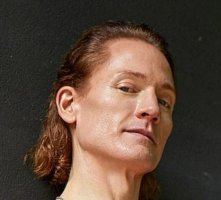You look fantastic! Plus this is super helpful. I didn't know about the nose and such. More things to watch.
You are using an out of date browser. It may not display this or other websites correctly.
You should upgrade or use an alternative browser.
You should upgrade or use an alternative browser.
How to go from 50+ to looking 20+ with plastic surgery rejuvenation.
- Thread starter MissOrange
- Start date
TPF may earn a commission from merchant affiliate
links, including eBay, Amazon, and others
- Status
- Not open for further replies.
More options
Who Replied?Just finished watching Fake Profile on netflix and Carolina Miranda is gorgeous. She is a 32 yo Mexican actress. I then thought I have a selfie from when I was brunette that looks a little similar so I made a pic collage for fun.
But as a bleached blonde with brown eyes I look more Asian without my glasses. I also look younger without the glasses too.
Two Chinese ladies met me and asked what I did for my skin. It never occurred to me that one's complexion can also reflect youthfulness. I do not use any Korean skin products as the only shop that sells them is in the West End and they tend to be expensive. I avoid chocolate which gives me acne from the sugar, in fact processed sugar is bad as it increases bacteria. I drink water, avoid the sun and use Clinique scrub as soap, moisturise with Garnier aloe vera (a huge bottle for £3) and apply Shiseido foundation without powder as this Japanese brand matches Asian faces perfectly. I loved how their mouths opened as they gasped when I revealed my age. No surprise as I can't believe I am 57 either.


But as a bleached blonde with brown eyes I look more Asian without my glasses. I also look younger without the glasses too.
Two Chinese ladies met me and asked what I did for my skin. It never occurred to me that one's complexion can also reflect youthfulness. I do not use any Korean skin products as the only shop that sells them is in the West End and they tend to be expensive. I avoid chocolate which gives me acne from the sugar, in fact processed sugar is bad as it increases bacteria. I drink water, avoid the sun and use Clinique scrub as soap, moisturise with Garnier aloe vera (a huge bottle for £3) and apply Shiseido foundation without powder as this Japanese brand matches Asian faces perfectly. I loved how their mouths opened as they gasped when I revealed my age. No surprise as I can't believe I am 57 either.


This 45 yo tech millionaire pays $2m a year for anti aging to have the heart of a 37 yo, skin of a 28 yo and fitness of an 18 yo. He takes 80 supplements a day. My concern is supplements may have silicon dioxide and other chemicals and at 80 a day that is a lot of an E food additive and may increase his risk of cancer.
His face continues to show signs of aging. His hairline is receding, he has a downward oral commissure, a droopy nose tip, loss of facial fat volume, loss of periorbital fat, pronounced nasolabial folds, skin pitting and the telltale sign of a facelift around his ear slightly in front of his tragus and downwards, etc. His face and skin looks 45-55 yo and not 18-28. For a man who wants to look and be 18 I am surprised he has not had a hair transplant, facial fat graft, nose tip rhinoplasty for starters. 18 yos have baby fat so to deplete his body of fat only accelerates aging in my opinion.
I would say his 29 yo doctor may be taking advantage of this rich man's vanity... a case of the Emperor's robe in my opinion. https://www.dailymail.co.uk/news/ar...-pills-day-blueprint-thatll-save-mankind.html

His face continues to show signs of aging. His hairline is receding, he has a downward oral commissure, a droopy nose tip, loss of facial fat volume, loss of periorbital fat, pronounced nasolabial folds, skin pitting and the telltale sign of a facelift around his ear slightly in front of his tragus and downwards, etc. His face and skin looks 45-55 yo and not 18-28. For a man who wants to look and be 18 I am surprised he has not had a hair transplant, facial fat graft, nose tip rhinoplasty for starters. 18 yos have baby fat so to deplete his body of fat only accelerates aging in my opinion.
I would say his 29 yo doctor may be taking advantage of this rich man's vanity... a case of the Emperor's robe in my opinion. https://www.dailymail.co.uk/news/ar...-pills-day-blueprint-thatll-save-mankind.html

Last edited:
Today I was buying Pimms at my local supermarket and was carded which I expected but what I did not expect was the store assistant’s reaction when I told her I was 57. She ignored me three times! I had to show her my dob on my driver’s licence and explain to her that that would make me 57 years old! She replied, “why do you keep saying 57?” Her brain would not accept that what she was looking at was a 57 year old lady! So I googled 57 year old Korean lady and came up with a dentist in her early 50s Lee Sujin and the Korean First Lady aged 60. What astonished me was the big difference between photoshopped images of Sujin on her IG and unedited ones. Why photoshop? Surely if one succeeds in rejuvenation, one does not still need to alter images? I think it is a shame and dishonest to post photoshopped images and have people believe you look like this in real life. No one can have such a cinched in waist in real life.










Thank you so much for these tips! I was wondering if you have some advice for me:
I'm painfully Caucasian with an oval face and rabidly seeing my face look more hollowed out and deep set as the years go by despite only being in my early 30s. I see how my parents ans older sisters have aged, and it's a look I'd like to avoid as long as possible. Because of that I've been very interested in getting fat grafting for my cheeks, undereye, and forehead to get a more youthful appearance, but I'm also on a bit of a weight-loss journey. About how much excess body fat do you think I would need to retain to graft and keep it in a stable/thriving state?
I'm painfully Caucasian with an oval face and rabidly seeing my face look more hollowed out and deep set as the years go by despite only being in my early 30s. I see how my parents ans older sisters have aged, and it's a look I'd like to avoid as long as possible. Because of that I've been very interested in getting fat grafting for my cheeks, undereye, and forehead to get a more youthful appearance, but I'm also on a bit of a weight-loss journey. About how much excess body fat do you think I would need to retain to graft and keep it in a stable/thriving state?
i just got a full facial fat graft-- is gaining weight necessary, or is maintaining fine? did you find any resources online that mention how to help fat grafts thrive better? (ive gotten a lot of varieties of advice from plastic surgery clinic websites lol)
Can u elaborate with picture pleaseToday’s post is on why some people get wide hypertrophic scars or keloids. My theory is that the surgeon may have used permanent sutures in the layers under the skin and the body is reacting to this in some people, trying to spit out sutures or reacting with inflammation and infection. My facelift scar is invisible as my surgeon used long acting pds dissolvable sutures under the skin for the deeper layers on my request. However for my periareolar mastopexy I suspect the surgeon used permanent sutures and my body reacted with a wide hypertrophic scar. My periareolar scarring looks wide and awful. It flattened with kenalog steroid injection but laser has made areas unevenly hyperpigmented. I am using a spray on tan over my chest to disguise some of the scarring. I am just grateful these scars are not on my face! One day I shall figure out how to fix the periareolar area but for now I will wait years and see what happens. I asked about tattooing but the technician said tattoo can darken areas but not lighten areas and I need the hyperpigmented lasered areas lightened back to skin colour.
I have a question in mind for so long
So for tummy tuck what’s the logic n science behind drains free tummy tuck
And which one should one get drains free or with drains ?
Please explain in detail Thankyou so much doc for all the efforts u do here without expecting anything in return ❤️
So for tummy tuck what’s the logic n science behind drains free tummy tuck
And which one should one get drains free or with drains ?
Please explain in detail Thankyou so much doc for all the efforts u do here without expecting anything in return ❤️
Hi @naimal, use of drains depends on the surgeon, the amount of bleeding and extent of resection. Most major operations use drains.I have a question in mind for so long
So for tummy tuck what’s the logic n science behind drains free tummy tuck
And which one should one get drains free or with drains ?
Please explain in detail Thankyou so much doc for all the efforts u do here without expecting anything in return ❤️
Sorry not posting intimate pictures.Can u elaborate with picture please
Hi @Benrina, the surgeon assesses your body to see if you have enough fat for harvesting for facial fat graft. Should be okay as not much is needed and it is often taken from the tummy or inner thighs. To maintain just don’t go below your surgery weight when you have facial fat grafting and try to gain 3-5 lbs post facial fat grafting for the first 4 months to help the grafted cells thrive. If after fat grafting your facial fat goes down, then keep eating fat and protein to help the cells recover. Facial hollowing may either be a result of too much weight loss, severe dehydration, premature aging or postmenopausal lack of oestrogen.Thank you so much for these tips! I was wondering if you have some advice for me:
I'm painfully Caucasian with an oval face and rabidly seeing my face look more hollowed out and deep set as the years go by despite only being in my early 30s. I see how my parents ans older sisters have aged, and it's a look I'd like to avoid as long as possible. Because of that I've been very interested in getting fat grafting for my cheeks, undereye, and forehead to get a more youthful appearance, but I'm also on a bit of a weight-loss journey. About how much excess body fat do you think I would need to retain to graft and keep it in a stable/thriving state?
Last edited:
Hi @beepboop4, after the face deswells, the grafted fat in the cheeks may drop to the lower face in 4-6 months or the fat reabsorbs leaving the face sagging. It is harder to maintain the fat in the upper cheeks as fat is heavy. Think of breast fat transfer and similarly it is hard to keep the fat graft in the upper pole as it drops due to the weight of fat. I recommend facial fat graft in the forehead, temples and upper eyelids but when it comes to the cheeks and lower face it is very unpredictable. I have had to have numerous repeat fat grafts to my cheeks and lower face as they reabsorbed unevenly, my lower face became sunken and my face sagged. Eventually one retains enough in the face and a lower facelift lifts up the fat graft and repositions in the cheeks better. In other words, once you have fat graft to the cheeks or lower face it is hard work to then maintain or try to achieve a lifted look as fat is heavy and if one gains weight, the fat hypertrophies and drags the skin down and causes nasolabial folds to appear. The lower face loses fat graft faster as we move our mouth when we eat and talk so a full face fat graft may end up very uneven and need multiple attempts to fix it. Facial fat graft in the cheeks and below takes a lot of persistence and repeated grafts to achieve longevity. I’ve actually got too much fat in my face in my honest opinion. But with aging, the facial fat will slowly go down so hoping I can have a slim face in my 60s. I always wonder what I would have looked like had I not had fat graft in my lower 2/3rds of my face and just stuck to having it in my upper third.btw did you mention that your previous fat grafts on your face went into your lower face and contributed to sagging? does this usually happen? i thought the fat would stay in the place where it was initially established :0
Last edited:
And what about under eye fat repositioningHi @beepboop4, after the face deswells, the grafted fat in the cheeks may drop to the lower face in 4-6 months or the fat reabsorbs leaving the face sagging. It is harder to maintain the fat in the upper cheeks as fat is heavy. Think of breast fat transfer and similarly it is hard to keep the fat graft in the upper pole as it drops due to the weight of fat. I recommend facial fat graft in the forehead, temples and upper eyelids but when it comes to the cheeks and lower face it is very unpredictable. I have had to have numerous repeat fat grafts to my cheeks and lower face as they reabsorbed unevenly, my lower face became sunken and my face sagged. Eventually one retains enough in the face and a lower facelift lifts up the fat graft and repositions in the cheeks better. In other words, once you have fat graft to the cheeks or lower face it is hard work to then maintain or try to achieve a lifted look as fat is heavy and if one gains weight, the fat hypertrophies and drags the skin down and causes nasolabial folds to appear. The lower face loses fat graft faster as we move our mouth when we eat and talk so a full face fat graft may end up very uneven and need multiple attempts to fix it. Facial fat graft in the cheeks and below takes a lot of persistence and repeated grafts to achieve longevity. I’ve actually got too much fat in my face in my honest opinion. But with aging, the facial fat will slowly go down so hoping I can have a slim face in my 60s. I always wonder what I would have looked like had I not had fat graft in my lower 2/3rds of my face and just stuck to having it in my upper third.
- Status
- Not open for further replies.
Register on TPF! This sidebar then disappears and there are less ads!

